Landblog Main
previous archive
First Visit 2007 -- 16 April 07 -- In 2005 and 2006, my seedlings from Burnt Ridge came just a few days after I ordered them. So this year I waited until right before I needed them... and they took almost three weeks! They came Friday, and yesterday (Sunday) I drove up, parked where the gravel turned to dirt, and got ready to walk in, because I didn't know if the roads were dry enough yet for 2wd. Then a pickup truck stopped... it was Eric, my new neighbor to the south, with his daughter. They gave me a ride in, and we had a lot to talk about. I told him some details of the property lines, and how to find the land on google maps, and he mentioned that this summer he wants to put a gate on the access road. That would be great, because it would block vehicles but not people on foot.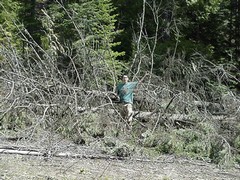 When I got up to the land I saw this. Two big trees, one of them maybe 70 feet long and two feet in diameter at the base, have fallen across the "parking lot." The needles are still soft and green, so they must have just fallen in the windstorm a week ago. These are both western hemlock -- the wood is stronger than cedar, and better for beams than douglas fir, so now I've got my beams for the cabin without having to kill any trees. I figure I'll also use it for the upper parts of the walls, and save my cedar for wood that's going to get wet or touch the ground.
When I got up to the land I saw this. Two big trees, one of them maybe 70 feet long and two feet in diameter at the base, have fallen across the "parking lot." The needles are still soft and green, so they must have just fallen in the windstorm a week ago. These are both western hemlock -- the wood is stronger than cedar, and better for beams than douglas fir, so now I've got my beams for the cabin without having to kill any trees. I figure I'll also use it for the upper parts of the walls, and save my cedar for wood that's going to get wet or touch the ground.Next I walked around and surveyed my plants. The blueberries got pruned a bit by deer, but oddly the cherries were untouched. I was worried about the walnuts, since I planted them in the fall in holes full of chunks of frozen dirt with no critter protection. But all six of them are healthy and budding, even the ones with the roots totally underwater. The sea buckthorns, supposely a much tougher plant, look awful! I lost the big one that I transplanted, and one of the five seedlings, and all of them have broken and dead branches. Also I lost an aronia and a serviceberry that I transplanted down off the north hill where they were struggling.
I had plenty of time this trip because I only had five trees to plant. First, two American chestnuts, the tree that used to stretch unbroken from the Atlantic to the Mississippi before the blight killed almost all of them. In the west, it's unlikely that my trees will be exposed to the blight, and I wanted American chestnut because it's the biggest tree, and more nearly native. They're also great for wood, and the nuts are a good source of starch.
Next, two Shagbark hickories. I decided to give up on pecans. Hickory doesn't produce as many nuts, but the wood is much better, and it's a better fit for my climate. But the holes I dug for them last fall, upslope from the pecan holes that filled up with water... were still full of water! So I grabbed the pick and made new holes even more upslope, getting close to some native trees that I'll have to cut down in a few years, if the hickories survive.
Finally, last year my Veteran peach never made it, so I found a replacement at a local garden center. (It was fun to look at a bunch of trees and pick out which one I was taking home.) In case there was something wrong with the first location, I planted it in a spot I'd been saving for an almond. I've decided not to grow almond unless I can get exactly what I want, Titan on Titan hybrid rootstock, which so far is not offered by any nursery.
Then I walked out to the car, picked up a bag of litter on the way, drove back to the housesit, and made a late order from Raintree. I'm going to throw good money after bad on the sea buckthorn, because it's one of the most useful plants in the world, and dammit, it should be easy to grow! I ordered two named cultivars (leikora) to replace the two dead ones, plus a good aronia, and four Nanking cherries. Nanking cherry is a bush, somewhere between a plum and a cherry, drought tolerant and cold hardy, with a tart cherry flavor, and they were cheap! I'm not sure where I'm going to plant them but I'll find a place. Finally, to fill a hole near the chestnut, I decided to get a Chinese Sweet Pit apricot. You can eat the fruit and the almond-like seed. The Hunza variety has a better seed, but its early blooms are very likely to be killed by late frosts, especially with the crazy weather these days.
Lies, Damned Lies, and Motivational Writing -- 24 April 07 -- I once read a joke about how you can tell beginning runners from experienced runners by their language: Beginners say things like "runner's high" and "second wind." And experienced runners say things like "something funny with my left knee."
In homesteading, beginners talk about math: x acres, y pounds of food per acre, xy pounds of food per year, and if one person eats z pounds of food in a year, then my little piece of land can feed an incredible xy/z people, which works out to denser than Tokyo!
All the numbers are true, except y, which is a damned lie. It works like this: Somebody grows apples, and if there's a blight, or a cool summer, or a dry summer, or a late or early frost, or a bee shortage, or they grew a less productive variety for flavor, or it was one of many varieties that produce good crops every other year, and this was the off year, then they don't report those numbers -- because those are not the "ideal" yields -- those are the real yields, and the ideal is the highest number they can find. Then someone compiles those numbers and picks the highest, and someone else compiles those and picks the highest, and you read it on the internet and think you can grow that much. It's true -- someone once did grow that much. It's also true that Wilt Chamberlain scored 100 points in one NBA game, and Reinhold Messner climbed the north slope of Everest alone with no supplemental oxygen.
Experienced homesteaders talk about setbacks and uncertainty and compromise. But unless they're very good with words, they'll be talking about that to a small audience. The popular books on food growing, or on any subject, are written by so-called "experts," or in more precise language, fanatical specialists. I noticed this last year about cabin building. Who writes books about building? People who have dedicated their lives to building, and love building. If you have only a small part of your life for building, and you're doing it because you have to, then a lot of their advice will not work for you. You don't want to know the exact perfect way to do it -- you want to know what you can get away with, how you can do the most with the least work. And even then, it's going to take you three times as long because you have neither the time nor the desire to work on the project 80 hours a week.
If you're a fanatical specialist, it's easy to grow 6000 pounds of food on one acre or build a cabin in a month -- what's difficult is resisting the temptation to become a motivational writer, to increase the size and enthusiasm of your audience by making it sound like anyone can do what you did and it's easy and fun. And then, when people don't get the experience you promised, they get discouraged and give up, and you've just done short term good and long term harm.
I'm not giving up on my land project -- on the contrary, I'm more motivated now by the need to fill the gap between the naive beginners and the deceptive experts, to set an example of having ordinary desire and ordinary results, and persisting.
Cabin and Motivation -- April-May 07 -- In March I got an email from Becky, who lives south of Spokane, has a truck, and is interested in helping out on my land. In April I invited her to help me haul up some plywood, so I can try to build an outhouse to make my land more friendly for visitors. She asked me to buy her gas, which is totally fair, but with a 20mpg vehicle, a round trip of 160 miles, and gas over $3 a gallon and rising, that works out to $25 a trip. I can't afford that more than a few times a year, and even if I could, it feels a little wasteful to burn one million BTU's of gasoline to bring in one thousand BTU's of human muscle work. (math)
Anyway, Becky was the first person to view my cabin site who knows a lot about green building, and what she told me was discouraging. My existing plan, which is already severely pushing the limits of what I can do, would produce a cabin that's too small, leans over, slides down the hill, has water leaking in the back, and has to be replaced in fewer years than the number of years it will take me to build it.
I've done a lot of research on building, and every time I write about my troubles I get plenty of advice. I'm familiar with Tom Brown's Guide to Living With the Earth and D.C. Beard's Shelters, Shacks, and Shanties, and Ianto Evans's and Becky Bee's cob house books, and Mike Oehler's underground house book, and Phil Garlington's Rancho Costa Nada, and straw bales and treehouses and tipis and yurts and earthships and papercrete and what the local Indians did. Some of these ideas can get me around not having a truck or much money, but none of them solve the deeper problem: that I'm working mostly alone and I have no pure love of building.
Basically, I've been trying to solve the cabin on a technical level, when it's not a technical problem! I've been thinking of myself as a robot, where the computer brain figures out the best design and commands the machine body to build it. But when I'm standing on the land with an axe and a shovel, I discover a whole different reality: A huge task that you love is better than a small task that you hate. The cabin is a psychological or spiritual problem: not to figure the easiest or most effective design, but to feel out a way of perceiving the project that makes me want to build.
When Chris suggested a Tom Brown thatched or mud hut, it occurred to me that I can go a long way just by changing my language. Take my most recent design: cordwood earth walls sitting straight on the ground, posts and beams supporting the loft, and a grass thatch roof. If I showed it to green building specialists and called it a "cabin," they would say, "Oh, no, that's a terrible cabin. You need a foundation, and good clay in the walls, and drainage, and a real roof. And it's too small." But if I called it a "hut," the same people might say, "That's a very nice hut, but you're overdoing it. You don't need that post and beam structure, and you can just use sticks in the walls instead of splitting all that wood. And it's too big!"
If I'm aiming for something in between a "cabin" and a "hut," calling it a "cabin" creates the awful tension of reaching for something I can't achieve. Some people might find that helpful, but I find it depressing. For me it works much better to call it a "hut," to set an easy low-stress goal and then find openings to go beyond it. (Patricia suggests I call it a "hubbin"!)
Also, I feel much better about using indigenous materials and hand tools. Sure, it will take me fewer hours if I use a chainsaw and pond liner and sheet metal, but if I'm going to do that, I no longer see any reason to live in the woods at all -- I'd rather wait for the housing market to bottom out, buy some pre-developed land in an abandoned suburb, and help it go wild. The vision of shaping the land into a house with my hands is what keeps me going through all these setbacks.
Finally, I enjoy doing things that (to my knowledge) have never been done before. I'm a scout, an experimenter. So, paradoxically, all the books I read about building made it more difficult -- they had the psychological effect of filling exciting new landscapes with tourists. Now I'm in a tight spot, but not a dead end. It will just be more of a challenge to come up with something new.
Spring 2007 Roundup -- 20 May 07 -- After a month my Raintree order finally came, so I immediately drove up and planted it: two Leikora sea buckthorns, a new variety of aronia, a sweet pit apricot, and four Nanking cherry bushes. I've previously planted eleven sea buckthorns from two nurseries at a total cost of $104 plus shipping, and every one has died. Possible causes range from dryness to fall planting to being too close to the native snowbrush. The new ones came in pots, in excellent condition, and I planted them in spring right next to an apple tree that's doing fine. If these die, sea buckthorns hate my land and I give up.
I've already given up on Carya species, pecan and hickory, which now have a zero in four survival rate. All six walnuts are still alive. If most of them survive the summer, next spring I'll try some other Juglans species, maybe a couple buartnuts.
Cherries and aronia (black chokeberry) are doing the best, with a 100% survival rate for named cultivars. The apple trees are all still alive, but the Golden Russet is struggling, and several of them have been munched by deer -- my favorite, the Prairie Spy, just lost a limb and half its leaves. I do not have the resources to put a seven foot fence around all my trees, so the best I can do against deer is to spray the leaves with repellant and leave plenty of native plants for them to eat. I might have to replace some trees, but I'm not giving up on apples because they're the only fruit that you can put in a box and eat all winter.
Now that Google maps has a nice satellite photo of the land, I managed to extract an image and print it, and I took it up there and walked around and marked the locations of all four corner posts... and one of them doesn't line up! It's roughly 100 feet off on a 660 foot side. I can't imagine the satellite photo being that distorted or the surveyors missing by that much, especially when the other three line up perfectly, so I'm not sure what's up. Luckily, the questionable border is not with a logging company but with my friendly neighbors to the south.
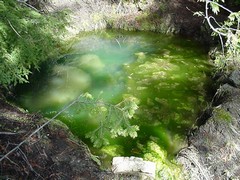 The Spring Job -- 29 May 07 -- This is what the spring looked like in April. The water tastes great, but I have yet to convince a visitor to try it, and I won't drink it myself in the summer when it gets pondy-smelling. Over the last two years I've considered a bunch of plans, including building a "springhouse" around the whole thing to keep out sunlight and organic matter, or putting a giant concrete cylinder around the place where the water comes up. I've dug down and found the source, under the big white balloon, and I've cleared all organic matter out of the pond three times, but it kept coming back. Finally I decided to dig a trench and run the water through a pipe to the slope below.
The Spring Job -- 29 May 07 -- This is what the spring looked like in April. The water tastes great, but I have yet to convince a visitor to try it, and I won't drink it myself in the summer when it gets pondy-smelling. Over the last two years I've considered a bunch of plans, including building a "springhouse" around the whole thing to keep out sunlight and organic matter, or putting a giant concrete cylinder around the place where the water comes up. I've dug down and found the source, under the big white balloon, and I've cleared all organic matter out of the pond three times, but it kept coming back. Finally I decided to dig a trench and run the water through a pipe to the slope below.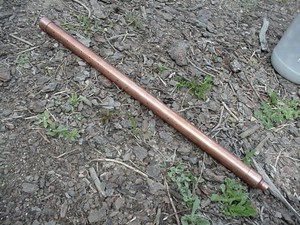 I wasn't sure how to capture the water, and Becky suggested a wide cylinder with a bunch of holes drilled in it, somehow connected to the pipe. I also had to decide on materials. I looked into ceramic pipes, but they're apparently made for nuclear plants and cost thousands of dollars. There are also stainless steel pipes and wide vitrified clay pipes, but Home Depot doesn't carry either, so I went with copper. For less than $40 I got a short fat pipe (one inch by two feet), a cap for one end, a joint for the other end to reduce the diameter to a half inch, and a ten foot long half inch pipe to carry the water out, all copper! In this photo is the collector pipe all ready to go. Completely guessing, I made 64 holes of 3/32 inches, easily with a hand drill.
I wasn't sure how to capture the water, and Becky suggested a wide cylinder with a bunch of holes drilled in it, somehow connected to the pipe. I also had to decide on materials. I looked into ceramic pipes, but they're apparently made for nuclear plants and cost thousands of dollars. There are also stainless steel pipes and wide vitrified clay pipes, but Home Depot doesn't carry either, so I went with copper. For less than $40 I got a short fat pipe (one inch by two feet), a cap for one end, a joint for the other end to reduce the diameter to a half inch, and a ten foot long half inch pipe to carry the water out, all copper! In this photo is the collector pipe all ready to go. Completely guessing, I made 64 holes of 3/32 inches, easily with a hand drill. 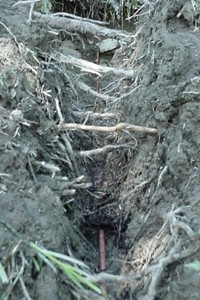 Even with a helper (thanks Troy!), it took several hours to dig the trench and drain the pool. I wanted to save as many of the roots as I could, and I ended up digging the last six inches with a stick, loosening the dirt and letting the flowing water wash it down.
Even with a helper (thanks Troy!), it took several hours to dig the trench and drain the pool. I wanted to save as many of the roots as I could, and I ended up digging the last six inches with a stick, loosening the dirt and letting the flowing water wash it down. 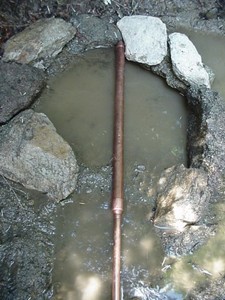 At the top of the photo on the left, you can see the collector resting against the white rock, and on the right is a closeup of the water collection area, which I decided to enclose in a loose rock wall. If you look closely, you can see tiny dark spots where the jets of water come up through the silt. Then I filled in and covered the whole enclosure with big gravel and little rocks, and covered it with sand.
At the top of the photo on the left, you can see the collector resting against the white rock, and on the right is a closeup of the water collection area, which I decided to enclose in a loose rock wall. If you look closely, you can see tiny dark spots where the jets of water come up through the silt. Then I filled in and covered the whole enclosure with big gravel and little rocks, and covered it with sand.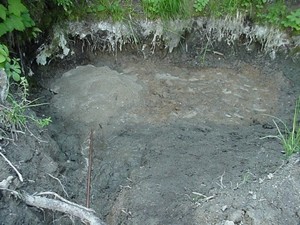 The sand came from the "parking lot," where I dug a little quarry and Troy and I hauled up many heavy buckets. We put silt on the right to try to fill in the bottom, and sand on the left around the water collector. Then, unexpectedly, the water in the upper pool continued rising even though the pipe was running at almost a half gallon a minute. I'm sure it will reach an equilibrium, where the pressure either increases the pipe flow or slows the spring flow. Then, depending on where the water level is, and how it tastes coming out of the pipe, I'll either fill it in with more sand and dirt, or leave it as a pool.
The sand came from the "parking lot," where I dug a little quarry and Troy and I hauled up many heavy buckets. We put silt on the right to try to fill in the bottom, and sand on the left around the water collector. Then, unexpectedly, the water in the upper pool continued rising even though the pipe was running at almost a half gallon a minute. I'm sure it will reach an equilibrium, where the pressure either increases the pipe flow or slows the spring flow. Then, depending on where the water level is, and how it tastes coming out of the pipe, I'll either fill it in with more sand and dirt, or leave it as a pool.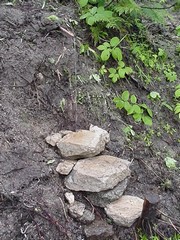 One more hitch: It turned out that twelve feet wasn't nearly long enough, so I had to pause the job for a few days until I could bring up another five feet of pipe. And here it is! The final step was to fit these rocks together to make a platform that will hold a gallon jug or five gallon bucket under the waterfall. Also, you can't see it, but I dug a new pool down below, with walls built up with dirt and muck from above, so I can fill watering buckets quickly and the critters can drink.
One more hitch: It turned out that twelve feet wasn't nearly long enough, so I had to pause the job for a few days until I could bring up another five feet of pipe. And here it is! The final step was to fit these rocks together to make a platform that will hold a gallon jug or five gallon bucket under the waterfall. Also, you can't see it, but I dug a new pool down below, with walls built up with dirt and muck from above, so I can fill watering buckets quickly and the critters can drink.